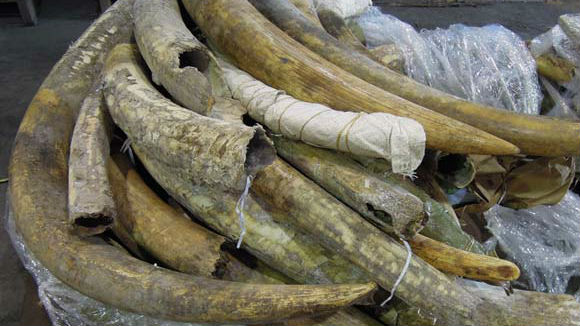Five Big Ivory Busts in Vietnam

Five significant ivory seizures have been made in the weeks leading up to Vietnam hosting a major intergovernmental event on illegal wildlife trade.
Vietnamese authorities confiscated over four and a half tons of trafficked ivory during October 2016. The first confiscation, a 309 kilogram shipment from Lagos, Nigeria, was made at Ha Noi’s Noi Bai International Airport on 1 October. The date coincided with the 17th Conference of the Parties to the Convention on International Trade in Endangered Species of Wild Fauna and Flora (CITES CoP17) taking place in South Africa, where Vietnam and other countries were reporting to the international community on their efforts to combat the illegal trade of wildlife products such as ivory and rhino horn.
The other seizures took place in Cat Lai Sea Port in Ho Chi Minh City. On October 6, the largest seizure - 569 pieces of ivory totalling two tons – was discovered, declared as timber from Mozambique.
Around 270 kilograms of Pangolin scales from Mozambique were seized on October 21 in a container along with 595 kilograms of ivory. Additionally almost a ton of ivory originating in Kenya and bound for Cambodia was seized, and on October 31, 446 kilograms ivory from Nigeria was seized.
The seizures took place just weeks ahead of the Hanoi Conference on the Illegal Wildlife Trade, which takes place on November 16-18. Representatives from around 50 nations will meet to review their progress in addressing wildlife crime following commitments made at the London Conference in 2014 and the Kasane Conference in 2015.
“In many ways these interdictions could not have come at a more opportune time for highlighting Vietnam’s significant role in international ivory trafficking,” said Tom Milliken, NGO TRAFFIC’s expert on ivory trade.
An analysis of the Elephant Trade Information System (ETIS), released just ahead of CITES CoP17, identified Vietnam as a “country of primary concern” because of its role as both a transit conduit and an end-use market for large quantities of ivory flowing from Africa to Asia. The report noted the growing evidence of ivory processing in Vietnam, especially for cross border ivory trade primarily catering to Chinese tourists.
Last year, TRAFFIC highlighted Da Nang Port in Vietnam as an emerging location of choice for trafficking ivory from Africa. The latest seizures at Cat Lai Sea Port signal the criminals behind the trafficking adapt quickly to enforcement efforts. However, according to the United Nations resident co-ordinator and the United Nations Office on Drugs and Crime, less than one percent of confiscations in Vietnam result in convictions.
The pressure on Vietnam is likely to rise further this week when the Wildlife Justice Commission, who investigate global organized criminal networks, holds a Public Hearing on November 14–15 at the Peace Palace in The Hague, Netherlands. There, a panel of expert witnesses will highlight the country’s ongoing failure to live up to its international obligations to end wildlife crime.
At next week’s Hanoi Conference on the Illegal Wildlife Trade, TRAFFIC will be calling on governments to implement their commitments made under the London Declaration and Kasane Statement and at CITES CoP17. These include commitments to close domestic ivory markets and phase out tiger and bear farms; enhance trade monitoring, anti-corruption activities and enforcement actions such as the use of controlled deliveries related to wildlife trafficking; improve relevant legislation and impose heavier penalties for wildlife crime and increase information exchange between enforcement agencies regionally and globally.
Ivory coming from recently-killed elephants
More than 90 percent of ivory in large, seized shipments came from elephants that died less than three years before, according to a new study.
A team of scientists at the University of Utah, the University of Washington (UW) and partner institutions came to this conclusion by combining a new approach to radiocarbon dating for ivory samples with genetic analysis tools developed by UW biology professor Sam Wasser.
“Apart from the actual killing, there’s the trade on the ground before it gets to ports, the actual shipments through shipping containers and then the problem of the demand side,” said Thure Cerling, the study’s lead author and professor of geology and geophysics at the University of Utah. “This additional information can be helpful to people trying to address those issues.”
In June 2016, the United States banned nearly all commerce in elephant ivory, which came 26 years after a ban on international trade in ivory. Both measures aimed to curtail the widespread poaching of elephants, whose numbers have plummeted since the 1980s.
Poaching still claims an estimated eight percent of African elephants each year, or around 96 elephants per day. Demand for elephant ivory and other illegal products derived from endangered animals has grown in Asia in recent years, opening a fresh battleground in the struggle against illegal ivory, even as U.S. markets shut down.
